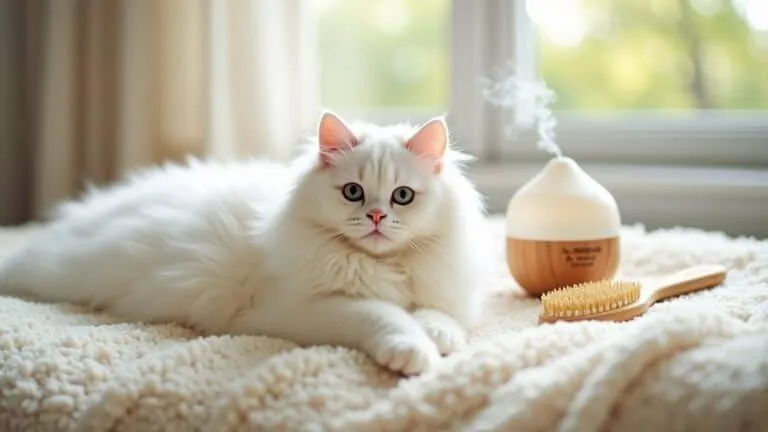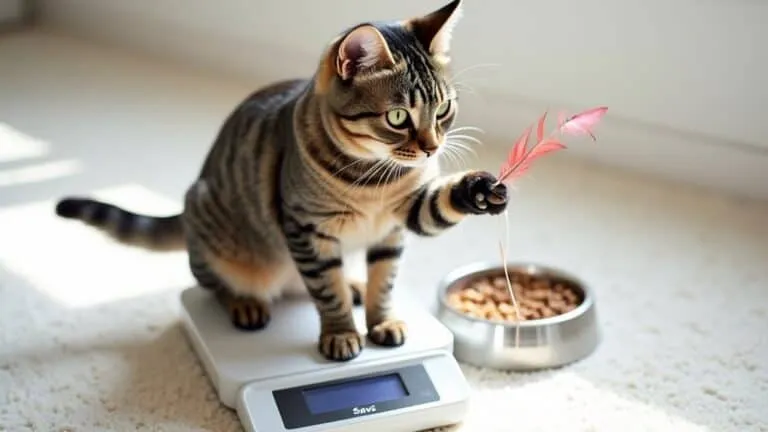The Best Fluffy Pancakes recipe you will fall in love with. Full of tips and tricks to help you make the best pancakes.

So you want to create a regular cat grooming schedule to keep your feline friend happy and healthy. This routine should include brushing, bathing, trimming nails, cleaning ears, and checking overall health. By doing this, you'll prevent hairballs, dental disease, and skin irritations, and you'll also strengthen your bond with your cat.
The frequency of grooming depends on your cat's hair length. If you have a long-haired cat, you should brush them daily. For medium-haired cats, aim for 1-2 times a week, and for short-haired cats, once a week is fine.
As for nail trimming, you should do it every 10-14 days. Ear cleaning can be done every few weeks.
By following these guidelines, you can create a customized grooming plan that suits your cat's unique needs. This will help ensure a happy and healthy feline companion.
Importance of Regular Grooming
Regular grooming is essential for your cat's overall health and wellbeing. It's not just about making them look good – it's about keeping their skin and fur healthy too. When you groom your cat regularly, you can prevent issues like hairballs and dental disease.
While you're grooming, you'll be able to spot any lumps, injuries, or skin irritations early on. This means you can get them to the vet sooner rather than later, which is really important. This regular interaction also helps strengthen the bond between you and your cat, making them more comfortable with the whole process.
Older cats really benefit from regular grooming too. As they get older, they might struggle to keep themselves clean, so a regular grooming schedule can help keep them clean and comfortable. By establishing a routine, you're not only keeping your cat looking their best, but you're also contributing to their overall health and wellbeing.
Essential Grooming Supplies Needed
To take good care of your cat, you'll need some essential supplies to help with their grooming.
First, you'll need the right brushes for your cat's coat. If your cat has long hair, you'll want a slicker brush. For short-haired cats, a bristle brush is the way to go.
When it's time for a bath, make sure you have cat shampoo and conditioner. Always dilute them before using to prevent skin irritation.
You'll also need some nail clippers specifically designed for cats. These clippers have a blunt tip to prevent damage to the nails.
Don't forget to get some ear cleaning solution and cotton balls to keep your cat's ears clean. This is especially important for cats that are prone to wax buildup or infections.
Finally, you'll need some dental tools like a cat toothbrush or some gauze paired with toothpaste that's safe for cats. This will help keep your cat's teeth and mouth healthy.
With these essential supplies, you'll be able to give your cat the care they need to stay healthy and happy.
Effective Grooming Techniques Explained
Now that you've got the essential supplies, it's time to prep for a successful grooming session.
Mastering specific techniques, like nail trimming, is key. You want to create a comfortable, stress-free environment for your cat.
Plus, you need a gentle and precise approach to trimming those delicate nails. Follow these guidelines and you'll be well on your way to making grooming a positive experience for both you and your feline friend.
Grooming Session Preparation
When you're getting ready for a grooming session with your cat, you want to create a calm and welcoming space that makes them feel secure and relaxed. This sets the tone for a positive experience.
Choose a quiet area that's free from distractions and noise. It's also a good idea to schedule grooming sessions after playtime or meals when your cat is likely to be calmer and more receptive to handling.
Introduce grooming tools gradually, using treats to create positive associations and reduce anxiety around the process. Pay attention to your cat's behavior and watch for signs of discomfort. Make sure handling is gentle and not overly stressful during grooming sessions.
Use positive reinforcement like praise and treats throughout the session to encourage a pleasant experience and build trust. This helps your cat feel relaxed and secure, making the grooming process a positive experience for both you and your feline friend.
Nail Trimming Procedure
When trimming your cat's nails, you need to be careful and precise to avoid causing them pain or making them bleed. This is a delicate process that requires attention to detail and a gentle touch.
Before you start clipping, gently inspect your cat's paws for any debris or irritants. You don't want anything getting in the way or causing discomfort.
To make things easier, use a swaddle technique or lap-hold to keep your cat stable and comfortable while you trim their nails. This will help them feel more secure and reduce stress.
Next, identify the quick of the nail. This is the pink area that contains blood vessels, and you want to avoid cutting into it to prevent bleeding and pain. So, be gentle and take your time.
When you're ready to clip, only trim the tips of the nails along their natural curve. Remove as little length as possible to maintain nail health. Don't cut too much, as this can cause pain and discomfort.
Remember to keep the environment calm during the procedure. Reducing stress can make the nail trimming experience more pleasant for both you and your cat.
Regular grooming, including nail trimming, is essential for your cat's overall health and well-being. By following these steps, you can help keep your cat's nails healthy and strong.
Brushing and Bathing Your Cat
When it comes to keeping your cat clean and well-groomed, regular brushing and bathing are a must. If you don't pay attention to these tasks, your cat's fur can get matted and tangled, and their skin can get irritated.
So, how often should you brush your cat? It really depends on the length of their hair. If your cat has long hair, you'll need to brush them daily. If they've medium-length hair, you can get away with brushing them one to two times a week. And if they've short hair, a weekly brushing session should do the trick.
Before you bathe your cat, it's essential to brush them first. This helps get rid of any loose hair and mats, which can clog up your drains. When you do bathe your cat, make sure to use lukewarm water and a shampoo that's specifically designed for cats. Never use human shampoo on your cat – it can be harmful to their skin.
Regular brushing has lots of benefits for your cat. It reduces shedding, promotes healthy skin and a healthy coat, and even helps distribute natural oils throughout their fur. It can also help reduce anxiety and stress, as long as you create a calm environment for grooming.
To make grooming sessions as stress-free as possible, prepare a peaceful space for both brushing and bathing. This will help your cat feel secure and relaxed.
Cleaning Your Cat's Ears and Teeth
Cleaning your cat's ears and teeth is a crucial part of their grooming routine. If you neglect these areas, it can lead to infections and serious health issues. But don't worry, regular maintenance can prevent these problems and keep your cat healthy and happy.
So, how do you clean your cat's ears? Start by checking their ears every few weeks for dirt, wax buildup, or odor. Use a feline-safe ear cleaning solution and cotton balls to clean the ears. Then, gently massage the base for 30 seconds to help loosen any debris.
When it comes to your cat's teeth, maintaining oral health is key. Brush their teeth regularly with a pet-safe toothbrush and toothpaste to prevent periodontal disease. If your cat resists tooth brushing, don't worry! You can try incorporating dental chews or treats as an alternative method.
It's also important to regularly inspect your cat's mouth for signs of gum disease, such as red or swollen gums, bad breath, or loose teeth. If you notice any abnormalities, be sure to consult your veterinarian.
Nail Trimming and Ear Care Tips
When you're grooming your cat, nail trimming and ear care are two important things to focus on. You need to be gentle and pay attention to details to avoid causing discomfort or health problems.
Trimming your cat's nails is crucial. You should do it every 10-14 days to prevent overgrowth. Use clippers specifically designed for cats to avoid damaging their nails. Identify the quick – the pink area – and only clip the white tip.
Ear care is also vital. Check your cat's ears regularly for dirt or wax buildup. Clean their ears with a feline-safe ear cleaning solution and cotton balls. Healthy ears should appear pink and clean. If you notice any signs of inflammation, consult a vet.
By prioritizing nail trimming and ear care, you can ensure your cat's overall well-being. Following these tips will prevent discomfort, pain, and potential health issues.
Be gentle when handling your cat's paws and ears, and make them comfortable with the process. Regular nail trimming will prevent overgrowth, and ear care will keep their ears clean and free from wax buildup.
Creating a Grooming Schedule
Creating a grooming schedule for your cat is super important. It helps keep them healthy and happy by preventing matting, tangling, and skin issues. To make a schedule that works, you need to consider a few key things.
First, think about your cat's coat type. If they have long hair, they need daily grooming. If they have medium hair, they need it 1-2 times a week. And if they have short hair, they need it once a week.
Nail trimming is also important. You should do it every 10-14 days, but you might need to do it more often if your cat is super active or spends a lot of time outdoors.
And don't forget about ear cleaning! You should clean your cat's ears every few weeks and keep an eye out for any problems during regular grooming sessions. This is especially important for cats that get a lot of wax buildup or infections.
Try to schedule grooming sessions when your cat is feeling chill, like after meals or playtime. This makes the experience way more enjoyable for both of you.
Use a calendar or app to keep track of when you need to do each task, so you can make sure you're covering all the bases. By following a schedule, you can help your cat live a happier, healthier life.
Preventing Hairballs and Fur Matts
When it comes to your cat's grooming schedule, there's one major thing to keep in mind: preventing hairballs and fur mats.
If you don't take care of these issues, they can lead to some serious health problems.
Regular brushing sessions are key to minimizing loose hair ingestion and preventing mat formation.
By making this a priority, you'll greatly reduce the risk of hairballs and fur mats.
And that means your cat will be happy and healthy.
Hairball Prevention Tips
Grooming is key to preventing hairballs and fur matts. A well-planned routine can greatly reduce the risk of these pesky problems. Cats need grooming to remove loose hair, which is a primary cause of hairball formation.
So, how can you prevent hairballs? Here are a few tips:
First, feed your cat a high-fiber diet. This aids digestion and helps fur pass more easily through the gastrointestinal tract, reducing hairball formation.
Next, make sure your cat has plenty of fresh water. Hydration keeps the gastrointestinal system functioning properly, minimizing the chances of hairballs forming.
Regular Brushing Sessions
So you want to take your hairball prevention efforts to the next level? Establishing a regular brushing routine can make a huge difference. This will help target loose hair and reduce the risk of fur matts. As you get into a regular grooming habit with your cat, you'll start to notice a significant decrease in hairballs and fur matts.
The frequency of brushing sessions really depends on your cat's coat length. If you've got a long-haired cat, daily brushing is the way to go. For medium-haired cats, 1-2 times a week should do the trick. And if you've got a short-haired cat, a weekly brushing session should be enough.
Regular brushing does a few important things. It helps remove loose hair, which reduces the risk of hairball formation and gastrointestinal blockages. You can use slicker or pin brushes to gently detangle mats and remove dead hair. This promotes a healthy, shiny coat and even stimulates your cat's skin.
During shedding seasons, you'll want to brush your cat every few days. This helps manage loose fur and prevents excessive hairballs and matting. By making regular brushing a habit, you'll be doing your cat a huge favor.
Making Grooming Enjoyable Experience
So, you want to make grooming a positive experience for your cat.
To do that, try scheduling these sessions during calm periods, like after meals, when your cat is more relaxed and open to the process. This sets the tone for a stress-free grooming session, making it more enjoyable for both you and your cat.
When it comes to guaranteeing a pleasant experience, here are some tips to follow:
First, use positive reinforcement. Give your cat treats and praise during and after the grooming session to create a positive association. This way, your cat will start to look forward to these sessions.
Next, keep it short and sweet. Start with short sessions of 5-10 minutes and gradually extend the duration as your cat becomes more comfortable with the process. You don't want to overwhelm them, so take it slow and easy.
Finally, maintain a calm atmosphere. Speak softly and use gentle, reassuring touches to keep your cat at ease. If you notice signs of stress, such as body tensing or tail swishing, take breaks and provide reassurance.
General Grooming Tips and Reminders
Set a grooming routine that's tailored to your cat's coat type. This will help prevent matting, hairballs, and other issues. Regular grooming maintains your cat's overall health and hygiene, and it can even strengthen your bond with them.
When it comes to grooming, it's essential to consider a few key aspects. First, your cat's coat type determines how often they need to be groomed. Long-haired cats need daily brushing, while short-haired cats require weekly grooming.
The environment where you groom your cat also matters. Choose a calm, safe space for grooming sessions to minimize stress. Your cat will appreciate the peaceful atmosphere, and it will make the experience more enjoyable for both of you.
Positive reinforcement is also crucial. Use treats and praise to create a pleasant association with grooming. This will help your cat look forward to these sessions and make them more cooperative.
Lastly, don't forget about nail trims. Schedule trims every 10-14 days, and handle your cat's paws gently to reduce anxiety. This will help make the experience less stressful and more comfortable for your cat.
Frequently Asked Questions
How Often Should a Cat Take to the Groomer?
So, how often should you take your cat to a professional groomer? Well, it really depends on their coat type. If your cat has a long or thick coat, they'll need to go more frequently to prevent matting and skin issues.
On the other hand, cats with shorter coats might not need to go as often. Either way, it's essential to use the right grooming tools at home and consult a pro for a personalized schedule that suits your cat's specific needs.
How Often Do I Need to Bathe My Cat?
So, how often do you really need to bathe your cat? The answer is, not very often. In fact, cats are pretty good at keeping themselves clean, so you usually don't need to intervene.
However, there are times when a bath is necessary. When that's the case, it's essential to do it gently and with the right products. You'll want to use feline-specific grooming products that are designed for their sensitive skin. This will help you avoid skin irritation and keep their natural coat healthy.
What Does a Full Grooming of a Cat Include?
So, when you're giving your cat a full grooming, you'll need to have a bunch of different tools on hand. These tools will help you cater to your cat's specific coat type, which is important for their overall skin care.
A full grooming typically includes a few key things. First, there's brushing, which helps get rid of any tangles or mats in your cat's fur. Then, there's bathing, which gets your cat clean and smelling fresh. You'll also need to trim your cat's nails to prevent overgrowth, clean their ears to prevent wax buildup, and provide some dental care to keep their teeth healthy. By doing all of these things, you can help keep your cat healthy and clean.
How Many Hours a Day Should Cats Groom?
Cats need to groom themselves daily to stay healthy and happy. The amount of time they spend grooming varies depending on their coat type. For instance, long-haired breeds usually need around 2-3 hours of grooming each day. This is because their long fur can easily get matted and tangled if not properly maintained.
On the other hand, short-haired cats typically require around 1-2 hours of grooming daily. This helps to keep their coat clean and shiny, and also reduces the risk of hairballs. To make grooming more effective, it's essential to use the right tools and follow a regular grooming routine.
Final Thoughts
Creating a cat grooming schedule is pretty straightforward. You've just got to make sure you're covering all the basics.
First, regular brushing and bathing are a must. These will help keep your cat clean and comfortable. Don't forget about those hard-to-reach areas, like the back of their ears and between their toes. Make sure to clean those spots regularly too.
The key to making grooming a positive experience is to stay calm and patient. If you're relaxed, your cat will be too. With a little practice, they'll even start to enjoy it.
The payoff is well worth the effort. A consistent grooming routine will leave your cat with a shiny, healthy coat. Plus, you'll strengthen your bond with them. So, stick to your schedule and you'll be rewarded with a happy, healthy cat.








